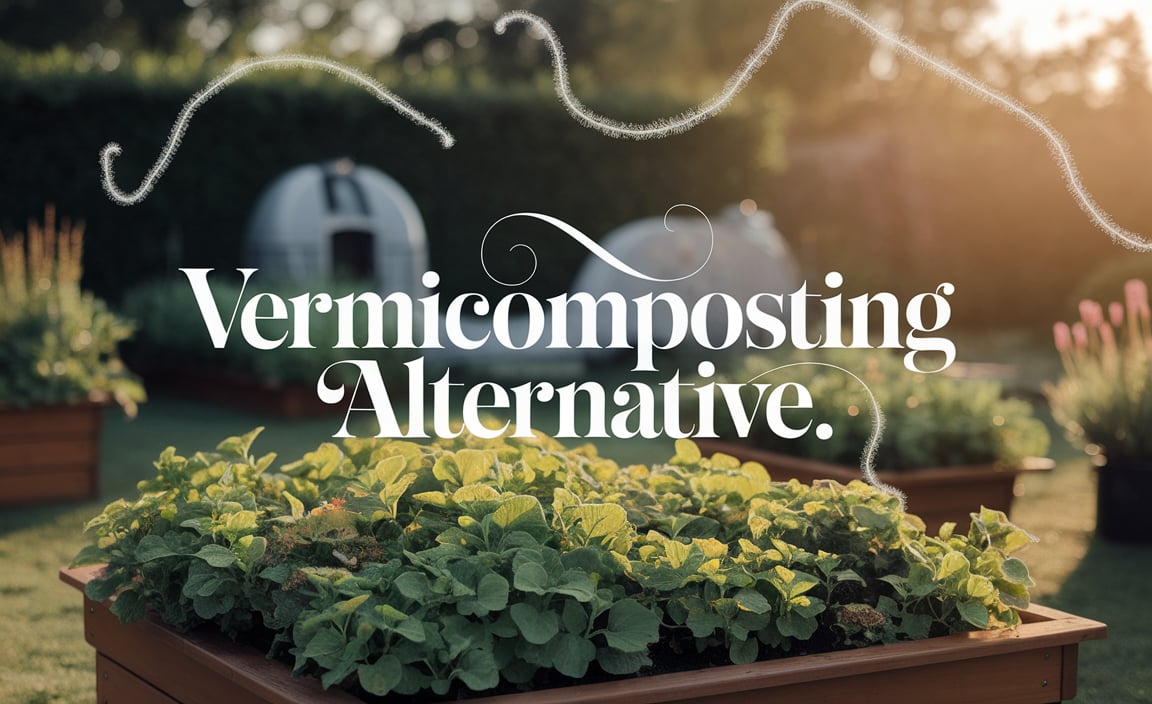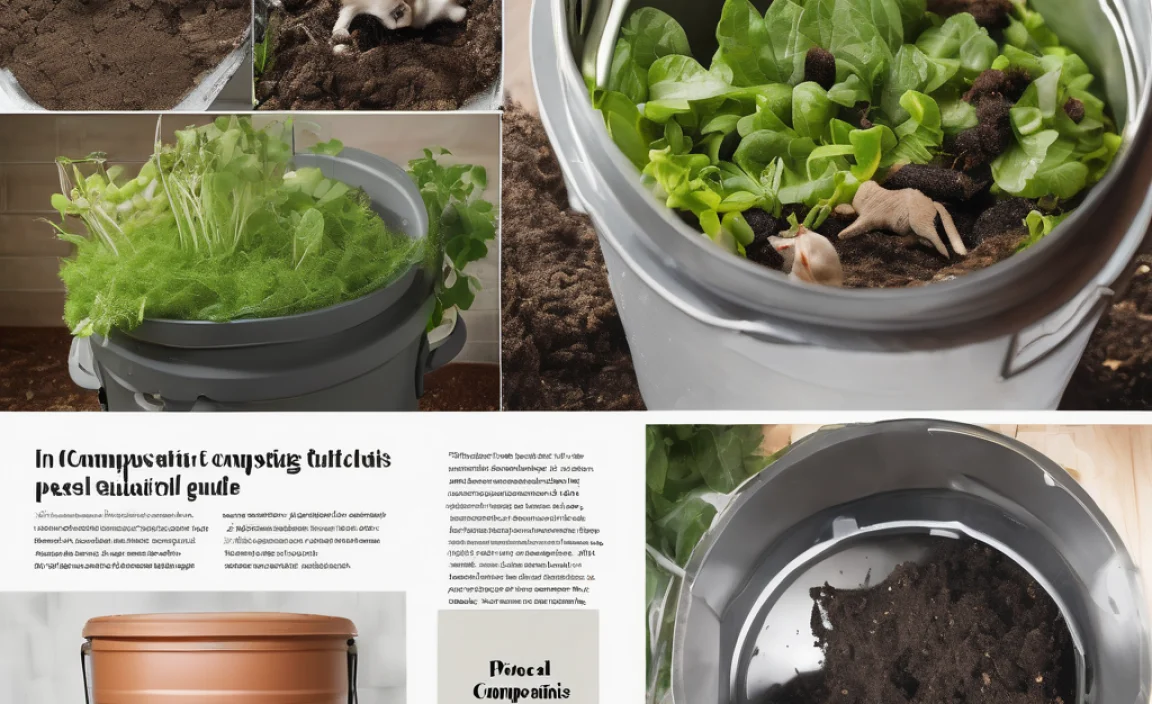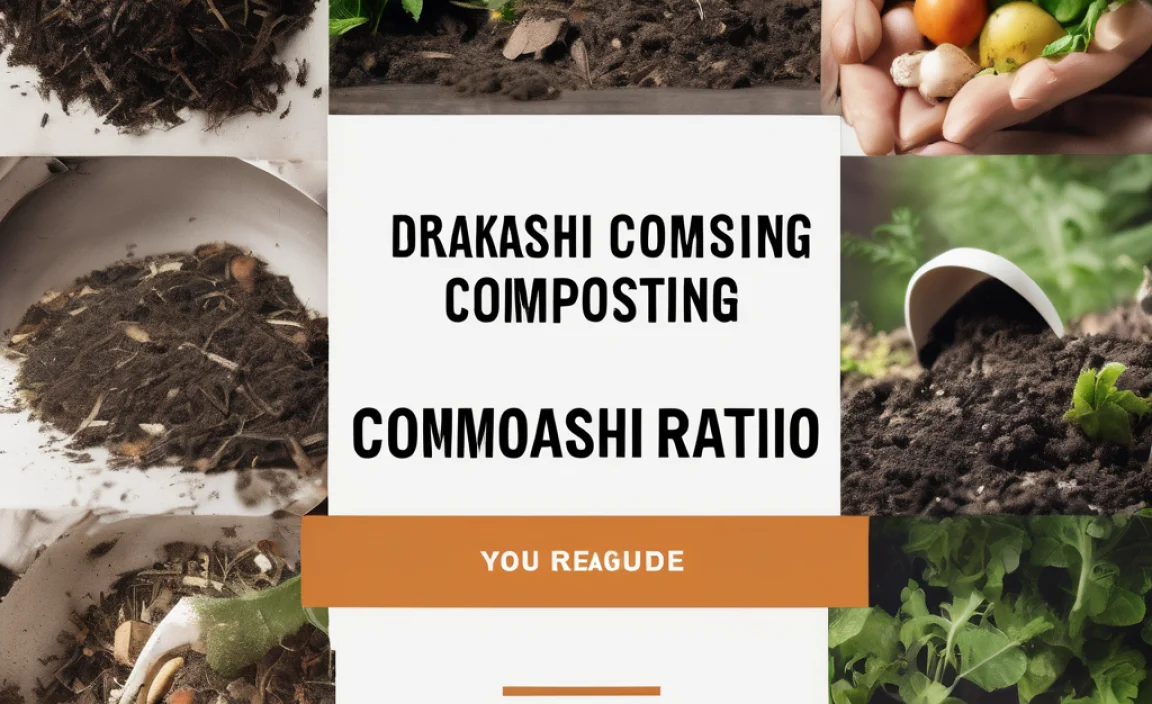Tired of that stinky compost bin or worried about wiggly worms? Thinking there must be an easier way to make awesome fertilizer for your garden? You’re not alone! Many folks find vermicomposting a bit… challenging. But don’t sweat it! There’s a fantastic, super-effective alternative that’s a breeze to set up and maintain. Let’s dive into the most proven method that can transform your kitchen scraps into garden gold without the fuss.

The Easiest Vermicomposting Alternative: Bokashi Composting
Hey there, garden lovers! Troy D Harn here from TopChooser, and I’m about to let you in on a composting secret that’s seriously simple and incredibly effective. If you’ve heard about vermicomposting (that’s worm composting, for those new to the lingo) and thought, “Nope, not for me!” then this is for you. We’re going to talk about an amazing vermicomposting alternative that’s taking the DIY and gardening world by storm: Bokashi composting. It’s cleaner, faster, and honestly, a whole lot less intimidating. Ready to ditch the worry and get to amazing, nutrient-rich soil? Let’s get started!
Why Look for a Vermicomposting Alternative?
Vermicomposting, while great, isn’t for everyone. Let’s be honest, the idea of managing a bin full of worms can be a bit off-putting for some. Here are a few common reasons folks seek out alternatives:
- Odor concerns: If not managed perfectly, worm bins can sometimes develop unpleasant smells.
- Temperature sensitivity: Worms are sensitive to extreme heat and cold, requiring careful placement and management.
- Pest worries: Fruit flies or other small critters can sometimes become a nuisance in vermicomposting setups.
- Maintenance: While not difficult, it does require a certain level of consistent attention to the worms’ needs.
- Dietary restrictions for worms: Not all food scraps are suitable for worms, which can feel limiting.
If any of these sound like your hesitations, then Bokashi is likely your perfect vermicomposting alternative. It’s a fermentation process, not decomposition, so it handles a wider range of scraps and doesn’t rely on the presence of live, delicate organisms like worms.
What Exactly is Bokashi?
Bokashi is actually a Japanese word meaning “Microbial Decomposition.” It’s an anaerobic (oxygen-free) fermentation process that uses a special inoculated bran mixture, sprinkled over your food scraps. This bran is packed with beneficial microbes, primarily Effective Microorganisms (EM™). These microbes work to pickle your food waste, breaking it down and preserving it without the nasty smells. Think of it like making super-powered sauerkraut for your scraps!
How Bokashi Composting Works: The Science (Simplified!)
Instead of worms munching through your waste, Bokashi relies on these little microbial helpers. They create an acidic environment that inhibits the growth of bad bacteria and fungi that cause rot and odor. Instead, they ferment the food waste. This process does a couple of cool things:
- It breaks down the waste into a more manageable state.
- It locks in nutrients, preventing them from escaping into the air as greenhouse gases.
- It prepares the waste for the final stages of decomposition, which happens much faster!
This makes Bokashi a fantastic vermicomposting alternative because it’s a closed system that can be done right in your kitchen, all year round, and handles a surprising variety of waste.
The Bokashi System: What You Need
Getting started with Bokashi is refreshingly simple. You don’t need a big outdoor bin, or any worms at all! Here’s your essential shopping list:
The Bokashi Bin
This is the heart of your Bokashi setup. A typical Bokashi bin is an airtight container that usually comes with a spigot at the bottom and a lid. You can buy dedicated Bokashi bins, or you can even make your own from two food-grade buckets using a simple DIY approach. The key is that it needs to be airtight to keep the oxygen out, which is crucial for the fermentation process.
What to look for:
- Airtight Lid: This is non-negotiable. It’s what creates the anaerobic environment.
- Spigot/Tap: This allows you to drain off the “Bokashi tea,” a nutrient-rich liquid byproduct. Make sure it’s easy to access and clean.
- Size: Choose a size that fits your kitchen space and the amount of food waste you generate. Many come in 5-gallon sizes.
- Food-grade plastic: Ensure the bin is made from materials safe for food contact.
You can often find Bokashi starter kits online that include the bin and the Bokashi bran, which is a great way to begin.
Bokashi Bran (The Magic Ingredient!)
This is the inoculated bran that kickstarts the fermentation. You can buy it online or at some garden supply stores. It’s essentially a carrier (like wheat or rice bran) that has been mixed with a culture of Effective Microorganisms (EM™). When you sprinkle it on your food scraps, the microbes get to work. Make sure to store your bran in a cool, dry place, and check the expiration date, as the microbial activity can decrease over time.
Looking for high-quality Bokashi bran? Reputable brands are readily available online. For more information on Effective Microorganisms and their application in composting, you can explore resources from institutions like the Oregon State University Extension, which often discusses sustainable soil management practices.
Your Kitchen Scraps
This is the fun part – all those things you used to throw away! Bokashi can handle a surprisingly wide range of food waste.
What Can You Compost with Bokashi?
This is where Bokashi really shines as a vermicomposting alternative. Unlike worm composting, Bokashi can handle:
- Fruit and vegetable scraps (peels, cores, etc.)
- Meat and fish scraps (bones and all!)
- Dairy products (cheese rinds, yogurt, etc.)
- Cooked foods and leftovers
- Coffee grounds and tea bags
- Small amounts of paper and cardboard (torn up)
- Eggshells
The main things to avoid are large amounts of liquids (like oils or directly pouring in soup – drain off excess moisture first!) and materials that are already heavily spoiled or moldy before you add them. The system is designed to ferment your food scraps, not to handle waste that’s already gone truly rotten.
Step-by-Step Guide: How to Bokashi Compost
Ready to get your hands dirty (but not too dirty)? Here’s how to set up and run your Bokashi system. It’s super simple!
Step 1: Prepare Your Bin
If you bought a dedicated Bokashi bin, it’s usually ready to go. If you’re making your own, ensure your buckets are clean and that one fits snugly inside the other (to catch the liquid), or that your single bucket has a tight-fitting lid and a spigot. Some people will put a small amount of gravel or marbles at the
bottom to help the liquid drain away from the food scraps.
Step 2: Add Your First Layer of Scraps
Start by adding a layer of your food scraps to the bin. Chop up larger items into smaller pieces – this helps them ferment more quickly and uniformly.
Step 3: Sprinkle with Bokashi Bran
Once you have a layer of scraps, sprinkle a generous tablespoon or two of Bokashi bran evenly over the top. Ensure it makes contact with the food waste.
Step 4: Press Down the Scraps
Use a tamper (or just a clean fist!) to press down the food scraps firmly. This helps remove air pockets and encourages the anaerobic fermentation process.
Step 5: Seal the Bin
Put the airtight lid on the Bokashi bin. You want to keep as much air out as possible. If your lid isn’t super tight, you can add a plastic bag liner inside the bin before putting the lid on to create a better seal.
Step 6: Repeat the Process
Continue adding food scraps, sprinkling with bran, and pressing down every time you add to the bin. Aim to add scraps daily or every few days. Always finish with a layer of bran on top, even if you’re not adding more scraps immediately, to ensure the surface stays covered.
Step 7: Drain the Bokashi Tea
When you drain the spigot, you’ll get a liquid byproduct sometimes called “Bokashi tea.” This liquid is packed with nutrients and beneficial microbes. It’s potent and needs to be diluted before use. A common dilution ratio is 1:100 (1 part tea to 100 parts water). You can use this diluted tea to water your plants, or add it to your garden soil to boost microbial activity. Empty the spigot every few days – don’t let it fill up!
Important Note on Bokashi Tea: While highly beneficial, undiluted Bokashi tea can be too strong for plants and may even harm them. Always dilute it significantly before applying. If you notice any foul smells coming from the liquid, it might indicate an issue with the fermentation and it’s best to discard it.
Step 8: When the Bin is Full: The Curing Phase
Once your bin is full, seal it tightly and let it sit for about two weeks. This is the “fermentation” or “pickling” stage. During this time, the microbes are actively working to break down the contents. You might notice some liquid is still produced, so keep draining it periodically.
Step 9: The Final Burial/Composting Stage
After the two-week fermentation period, your scraps are not yet “finished” compost. They are pickled and partially broken down. You now need to “bury” them to complete the decomposition process and allow them to turn into nutrient-rich soil. You have a few options:
Option A: Bury in Garden Beds
Dig a hole about 12 inches deep in your garden bed, compost pile, or a large planter. Empty the fermented Bokashi contents into the hole and cover it completely with soil. Avoid planting directly on top of the fresh burial site for at least two weeks to allow the material to fully integrate into the soil.
Option B: Bury in a Potting Mix
If you don’t have garden beds, mix the fermented contents with soil or compost in a large container and let it sit for another 2-4 weeks, covered, before using it as potting mix. This allows for secondary decomposition.
Option C: Add to a Traditional Compost Pile
You can add the fermented Bokashi contents to a hot compost pile or even a worm bin (in small amounts, added gradually). Since the material is already partially broken down and fermented, it will speed up the composting process in the pile.
The key is to expose the fermented material to oxygen and soil microbes in the final stage. This is the crucial step that turns your pickled scraps into usable compost.
Pros and Cons of Bokashi Composting (A Vermicomposting Alternative Comparison)
Like any method, Bokashi has its strengths and weaknesses. Understanding these will help you see why it’s a top vermicomposting alternative for many.
| Pros | Cons |
|---|---|
| Handles a Wide Range of Waste: Can compost meat, dairy, and small bones. | Requires a Second Stage: The fermented material needs to be buried or further composted. It’s not finished compost directly from the bin. |
| Odor-Free: The airtight system prevents foul smells. It smells slightly pickled, not rotten. | Ongoing Cost: Requires purchasing Bokashi bran regularly. |
| Compact & Kitchen-Friendly: Can be done indoors, year-round, in a small space. | Bokashi Tea Management: Needs to be diluted and used promptly; can become smelly if left too long. |
| Faster Initial Breakdown: Fermentation is quicker than traditional composting. | Draining is Essential: Forgetting to drain the tea can lead to anaerobic conditions that produce unwanted byproducts. |
| Nutrient Retention: Less nutrient loss to the atmosphere during fermentation. | Requires Two Systems: You need the Bokashi bin for fermentation and then a place to bury/finish the compost. |
| Reduces Landfill Waste Significantly. | Initial Setup Cost: Buying the bin and bran can be an initial investment. (DIY bins can reduce this.) |
So, Is Bokashi the “Best” Vermicomposting Alternative?
For many people, especially those living in apartments, with limited outdoor space, or those who want to compost meat and dairy without hassle, Bokashi is indeed the best vermicomposting alternative. It offers speed, convenience, and odor control that traditional composting or even vermicomposting might struggle to match in specific environments. The need for a second burial or composting stage is a minor trade-off for the ease and versatility it provides.
Tips for Successful Bokashi Composting
Here are some straightforward tips to make your Bokashi journey smooth sailing:
- Chop It Up: Smaller pieces of food waste will ferment faster and more thoroughly.
- Press it Down: Always press the scraps after adding them to remove air.
- Keep it Airtight: Ensure the lid is sealed tightly after each use.
- Drain Regularly: Don’t let that Bokashi tea build up. Drain it every few days.
- Use Fresh Bran: Check the expiry date on your Bokashi bran to ensure microbial activity is high.
- Don’t Overload: If you generate a lot of waste, consider having two bins so one can ferment while the other is being filled.
- Bury Properly: Ensure adequate soil cover when burying the fermented material.
- Be Patient: The final decomposition after burying can take a few weeks.
Bokashi vs. Vermicomposting: Key Differences
To really see why Bokashi is a great vermicomposting alternative, let’s break down how they differ:
| Feature | Vermicomposting | Bokashi Composting |
|---|---|---|
| Process | Decomposition by worms | Anaerobic fermentation by microbes |
| Input Waste | Primarily fruits, vegetables, coffee grounds, paper. Limited meat/dairy. | Fruits, vegetables, meat, dairy, bones, cooked foods, paper. |
| Odor | Can potentially smell if not managed correctly. | Slightly acidic, pickled smell; generally odorless. |
| Temperature | Sensitive to extreme heat/cold; requires specific temp range. | Can be done in any temperature; indoors is ideal. |
| Speed | Slower, continuous process. | Fast fermentation (2-4 weeks), followed by burial/secondary decomposition. |
| Byproduct | Worm castings (finished compost). | Bokashi tea (liquid fertilizer) and fermented food waste (requires burial). |
| Maintenance | Feeding worms, managing moisture, bedding. | Adding scraps, sprinkling bran, draining liquid, burying fermented waste. |
As you can see, Bokashi offers a distinct set of advantages, making it a compelling vermicomposting alternative for many households.
Frequently Asked Questions About Bokashi
Can I use Bokashi if I live in an apartment?
Absolutely! Bokashi is perfect for apartment dwellers. The bin is compact, seals tightly to control odors, and can be kept right inside your kitchen. The only consideration is where you’ll bury the fermented waste, but many people find solutions using balcony planters or community garden plots.
What does “Bokashi tea” smell like?
Properly made Bokashi tea smells slightly acidic and vinegary, similar to pickle juice. If it smells truly foul or rotten, something may have gone wrong with the anaerobic process, and it’s best to discard it.
How long does the Bokashi bran last?
Bokashi bran is best used within 12-18 months of its manufacture date, when stored properly in a cool, dry, dark place.

I am passionate about home engineering. I specialize in designing, installing, and maintaining heating, ventilation, and air conditioning systems. My goal is to help people stay comfortable in their homes all year long.


